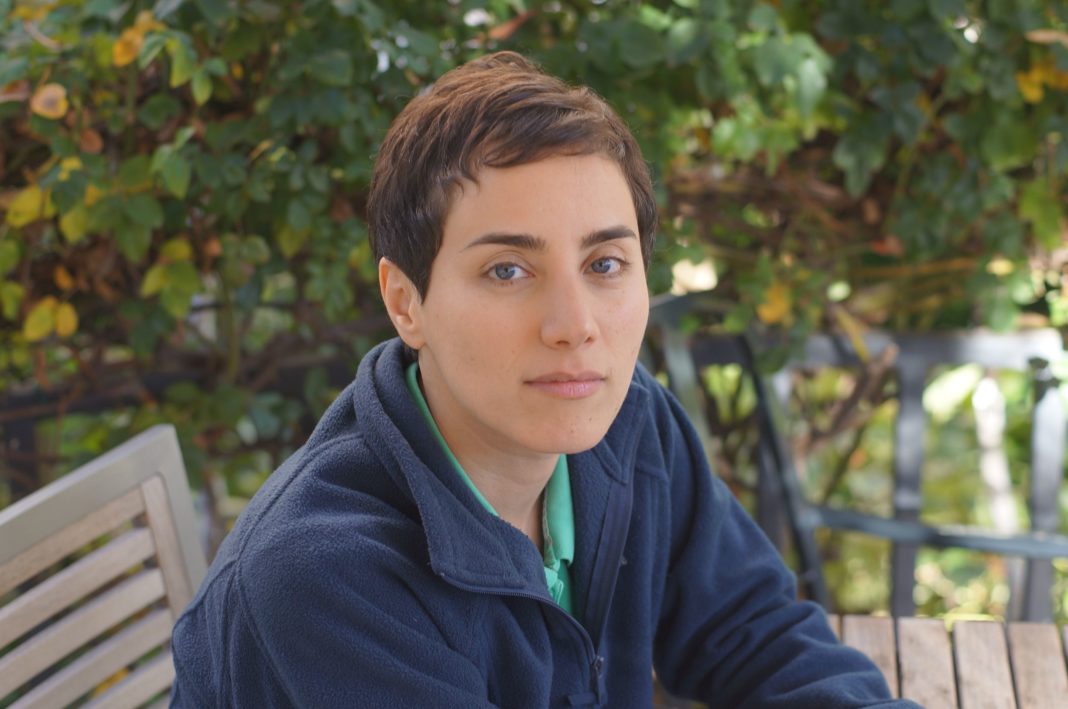
She was 17 when she won the gold medal at the 1994 International Math Olympiad; in 1995, she again won the gold medal — this time, with a perfect score. In 1999, the girl who grew up in a tumultuous time during the Iran-Iraq war earned her bachelor’s degree from Sharif University of Technology, Tehran.
At 27, Maryam Mirzakhani had completed her Ph.D. at Harvard University. From 2004 to 2008, the Iranian mathematics genius served as a Clay Mathematics Institute Research Fellow and an assistant professor at Princeton University.
In 2008, the 31-year-old became a professor of mathematics at Stanford; six years later, Mirzakhani became the first woman in 78 years to be awarded the Fields Medal, known as the Nobel Prize for Mathematics. Mirzakhani was selected for the world’s most prestigious mathematics prize for discovering “stunning advances in the theory of Riemann surfaces and their moduli spaces.” Stanford News reported:
“The award recognizes Mirzakhani’s sophisticated and highly original contributions to the fields of geometry and dynamical systems, particularly in understanding the symmetry of curved surfaces, such as spheres, the surfaces of doughnuts and of hyperbolic objects. Although her work is considered “pure mathematics” and is mostly theoretical, it has implications for physics and quantum field theory.”
Though today her research interests in Teichmüller theory, Hyperbolic geometry, Ergodic theory, and Symplectic geometry has the potential to influence material science, engineering, quantum field theory, and even theoretical physics, as a child Mirzakhani’s passion was not in numbers, but literature.
In an interview for the Clay Mathematics Institute (CMI) in 2008, she explained what inspired her to take up mathematics:
“As a kid, I dreamt of becoming a writer. My most exciting pastime was reading novels; in fact, I would read anything I could find. I never thought I would pursue mathematics before my last year in high school. My older brother was the person who got me interested in science in general.
“My first memory of mathematics is probably the time that he told me about the problem of adding numbers from 1 to 100. Later, I got involved in Math Olympiads that made me think about harder problems. As a teenager, I enjoyed the challenge. But most importantly, I met many inspiring mathematicians and friends at Sharif University. The more I spent time on mathematics, the more excited I became.”
The low representation of women in STEM academic faculty and leadership roles (only 9% to 16% of tenure-track positions in mathematics are held by women at the top 100 US universities) is unexplainable. But Mirzakhani hopes her achievements will inspire and encourage many more women scientists and mathematicians to reach for their dreams and win the honor in coming years:
“I have enjoyed a pleasant and supportive environment during my time at Harvard, Princeton, and Stanford. Still, in my opinion, the situation of women in math is far from ideal. The social barriers for girls who are interested in mathematical sciences might not be lower now than they were when I grew up.
“And balancing career and family remains a big challenge. It makes most women face difficult decisions which usually compromise their work. However, there has been a lot of progress over the years, and I am sure this trend will continue.”
Sir Tim Gowers, a Fields medalist and mathematician at Cambridge University, echoes her thoughts:
“I am thrilled that this day has finally come. Although women have contributed to mathematics at the highest level for a long time, this fact has not been visible to the general public. I hope that the existence of a female Fields medalist, who will surely be the first of many, will put to bed many myths about women and mathematics, and encourage more young women to think of mathematical research as a possible career.”
 The Fields Medal is awarded once every four years by the International Mathematical Union to outstanding talents under the age of 40, in the field of mathematics. But this is the first time a woman had won the prize since the award was established in 1936. Christiane Rousseau, vice president of the International Mathematics Union, commented:
The Fields Medal is awarded once every four years by the International Mathematical Union to outstanding talents under the age of 40, in the field of mathematics. But this is the first time a woman had won the prize since the award was established in 1936. Christiane Rousseau, vice president of the International Mathematics Union, commented:
“It’s an extraordinary moment. Marie-Curie had Nobel prizes in physics and chemistry at the beginning of the 20th century, but in mathematics this is the first time we have a woman winning the most prestigious prize there is. This is a celebration for women.”
Though a way out of gender disparities in STEM fields isn’t coming anytime soon, Mirzakhani has cracked a glass ceiling; her success is hugely symbolic, and her Fields Medal is a sign of change to come – which will go down in history as the moment when one of the last bastions of male dominance fell.
This article (Meet Maryam Mirzakhani, The First Woman to Win the “Nobel Prize of Mathematics”) is a free and open source. You have permission to republish this article under a Creative Commons license with attribution to the author and AnonHQ.com.
Supporting Anonymous’ Independent & Investigative News is important to us. Please, follow us on Twitter: Follow @AnonymousNewsHQ




